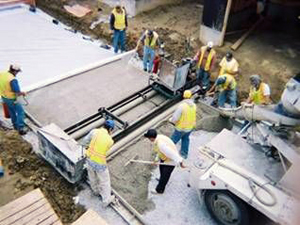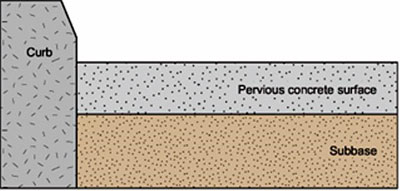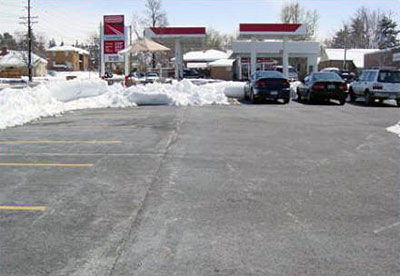Engineering Properties
Fresh Properties
The plastic pervious concrete mixture is stiff compared to traditional concrete. Slumps, when measured, are generally less than ¾ inches (20 mm), although slumps as high as 2 inches (50 mm) have been used. When placed and compacted, the aggregates are tightly adhered to one another and exhibit the characteristic open matrix.
 For quality control and quality assurance, unit weight or bulk density is the preferred measurement because some fresh concrete properties, such as slump, are not meaningful for pervious concrete. Conventional cast-cylinder strength tests are also of little value, because the field consolidation of pervious concrete is difficult to reproduce in cylindrical test specimens, and strengths are heavily dependent on the void content. Unit weights of pervious concrete mixtures are approximately 70% of traditional concrete mixtures.
For quality control and quality assurance, unit weight or bulk density is the preferred measurement because some fresh concrete properties, such as slump, are not meaningful for pervious concrete. Conventional cast-cylinder strength tests are also of little value, because the field consolidation of pervious concrete is difficult to reproduce in cylindrical test specimens, and strengths are heavily dependent on the void content. Unit weights of pervious concrete mixtures are approximately 70% of traditional concrete mixtures.
Concrete working time is typically reduced for pervious concrete mixtures. Usually, one hour between mixing and placing is all that is recommended. However, this can be controlled using retarders and hydration stabilizers that extend the working time by as much as 1.5 hours, depending on the dosage.
Hardened Properties
Density and Porosity

Subgrade
Figure 3. Typical cross section of pervious concrete pavement. On level subgrades, stormwater storage is provided in the pervious concrete surface layer (15% to 25% voids), the subbase (20% to 40% voids), and above the surface to the height of the curb (100% voids).
The density of pervious concrete depends on the properties and proportions of the materials used, and on the compaction procedures used in placement. In-place densities on the order of 100 lb/ft³ to 125 lb/ft³ (1600 kg/m³ to 2000 kg/m³) are common, which is in the upper range of lightweight concretes. A pavement 5 inches (125 mm) thick with 20% voids will be able to store 1 inch (25 mm) of a sustained rainstorm in its voids, which covers the vast majority of rainfall events in the U.S. When placed on a 6-inch (150-mm) thick layer of open-graded gravel or crushed rock subbase, the storage capacity increases to as much as 3 inches (75 mm) of precipitation (see Figure 3 and Hydrological Design Considerations).
Permeability
The flow rate through pervious concrete depends on the materials and placing operations. Typical flow rates for water through pervious concrete are 3gal/ft²/min (288 in./hr, 120 L/m²/min, or 0.2 cm/s) to 8 gal/ft²/min (770 in./hr, 320 L/m²/min, or 0.54 cm/s), with rates of up to 17 gal/ft²/min (1650 in./hr, 700 L/m²/min, 1.2 cm/s). Even higher rates have been measured in the laboratory.
Compressive Strength
In the laboratory, pervious concrete mixtures have been found to develop compressive strengths in the range of 500 to 4000 psi (3.5 MPa to 28 MPa), which is suitable for a wide range of applications. Typical values are about 2500 psi (17 MPa). As with any concrete, the properties and combinations of specific materials, as well as placement techniques and environmental conditions, will dictate the actual in-place strength. However, currently there is no ASTM test standard for compressive strength of pervious concrete. Testing variability measured with various draft test methods has been found to be high and therefore compressive strength is not recommended as an acceptance criterion. Rather, it is recommended that a target void content (between 15% to 25%) as measured by ASTM C 1688: Standard Test Method for Density and Void Content of Freshly Mixed Pervious Concrete, be specified for quality assurance and acceptance. As stated in ACI 522.1-13: Specification for Pervious Concrete Pavement, the tolerance for the specified void content is +/-5%.
Flexural Strength
Flexural strength in pervious concretes generally ranges between about 150 psi (1 MPa) and 550 psi (3.8 MPa). Many factors influence the flexural strength, particularly degree of compaction, porosity, and the aggregate-to-cement (A/C) ratio. However, the typical application constructed with pervious concrete does not require the measurement of flexural strength for design.
Shrinkage
Drying shrinkage of pervious concrete develops sooner, but is much less than conventional concrete. Specific values will depend on the mixtures and materials used, but values on the order of .002 have been reported, roughly half that of conventional concrete mixtures. The material’s low paste and mortar content is a possible explanation. Roughly 50% to 80% of shrinkage occurs in the first 10 days, compared to 20% to 30% in the same period for conventional concrete. Because of this lower shrinkage and the surface texture, many pervious concretes are made without control joints and allowed to crack randomly.
Durability
Freeze-Thaw Resistance
Freeze-thaw resistance of pervious concrete in the field appears to depend on the saturation level of the voids in the concrete at the time of freezing. In the field, it appears that the rapid draining characteristics of pervious concrete prevent saturation from occurring. Anecdotal evidence also suggests that snow-covered pervious concrete clears quicker, possibly because its voids allow the snow to thaw more quickly than it would on conventional pavements. In fact, several pervious concrete placements in North Carolina and Tennessee have been in service for over 10 years.
 Note that the porosity of pervious concrete from the large voids is distinctly different from the microscopic air voids that provide protection to the paste in conventional concrete in a freeze-thaw environment. When the large open voids are saturated, complete freezing can cause severe damage in only a few cycles. Standardized testing by ASTM C 666 may not represent field conditions fairly, as the large open voids are kept saturated in the test, and because the rate of freezing and thawing is rapid. It has been shown that even after 80 cycles of slow freezing and thawing (one cycle/day), pervious concrete mixtures maintain more than 95% of their relative dynamic modulus, while the same mixtures showed less than 50% when tested at a more rapid rate (five to six cycles/day). It was noted that better performance also could be expected in the field because of the rapid draining characteristics of pervious concrete.
Note that the porosity of pervious concrete from the large voids is distinctly different from the microscopic air voids that provide protection to the paste in conventional concrete in a freeze-thaw environment. When the large open voids are saturated, complete freezing can cause severe damage in only a few cycles. Standardized testing by ASTM C 666 may not represent field conditions fairly, as the large open voids are kept saturated in the test, and because the rate of freezing and thawing is rapid. It has been shown that even after 80 cycles of slow freezing and thawing (one cycle/day), pervious concrete mixtures maintain more than 95% of their relative dynamic modulus, while the same mixtures showed less than 50% when tested at a more rapid rate (five to six cycles/day). It was noted that better performance also could be expected in the field because of the rapid draining characteristics of pervious concrete.
Research indicates that entrained air in the paste dramatically improves freeze-thaw protection for pervious concrete. In addition to the use of air-entraining agents in the cement paste, placing the pervious concrete on a minimum of 6 inches (150 mm), and often up to 12 (300 mm) or even 18 inches (450 mm) of a drainable rock base, such as 1-inch (25-mm) crushed stone, is normally recommended in freeze-thaw environments where any substantial moisture will be encountered during freezing conditions.
Sulfate Resistance
Aggressive chemicals in soils or water, such as acids and sulfates, are a concern to conventional concrete and pervious concrete alike, and the mechanisms for attack are similar. However, the open structure of pervious concrete may make it more susceptible to attack over a larger area. Pervious concretes can be used in areas of high-sulfate soils and groundwaters if isolated from them. Placing the pervious concrete over a 6-inch (150-mm) layer of 1-inch (25-mm) maximum top size aggregate provides a pavement base, stormwater storage, and isolation for the pervious concrete. Unless these precautions are taken in aggressive environments, recommendations from ACI 201 on water-to-cement ratio and material types/proportions should be followed strictly.
Abrasion Resistance
Because of the rougher surface texture and open structure of pervious concrete, abrasion and raveling of aggregate particles can be a problem, particularly where snowplows are used to clear pavements. This is one reason why applications such as highways are generally not suitable for pervious concretes. However, anecdotal evidence indicates that pervious concrete pavements allow snow to melt faster, requiring less plowing.
Most pervious concrete pavements will have a few loose aggregates on the surface in the early weeks after opening to traffic. These rocks were loosely bound to the surface initially, and popped out because of traffic loading. After the first few weeks, the rate of surface raveling is reduced considerably and the pavement surface becomes much more stable. Proper compaction and curing techniques reduce the occurrence of surface raveling.


